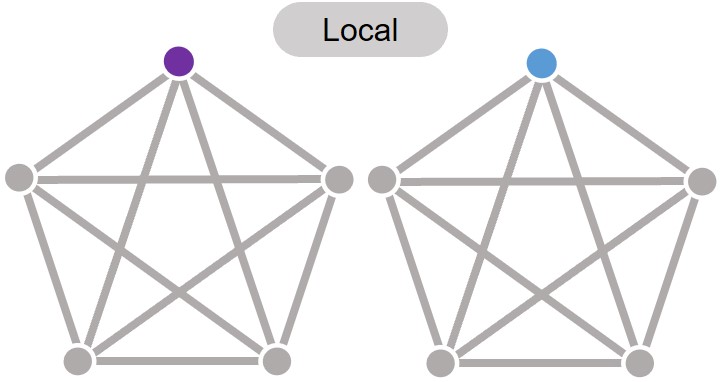Unigraph#
Consider two unipartite graphs
and
where edges between two vertices from the same set are only available are used to demarcate local residue-residue connections (LocRRCs, see here). A LocRRC is formed by any two elements from set VP or set VQ. We introduce a few kinds of unigraphs.
Fully-connected#
Here, we mainly want to show how to construct a unipartite graph in Python, which can be recognised by TMKit. The unipartite graph is constructed by considering residue pairs in a fully-connected manner, as shown in the plot below.

Caption: Connections in a fully-connected manner in a unipartite graph.#
Tip
If there are two residues 1 and 2, how does TMKit find them and their neighbouring residues?
In fact, either is marked by the coordinate 0. If a neighbouring residue appears on the left side of residue 1, the coordinate of the neighbouring residue is -1 (which will be paired to residue 1 per se), and a neighbouring residue appear on the right side of residue 1 the coordinate of the neighbouring residue is 1 (which will be paired to residue 1 per se).
In TMKit, we use the function below to generate a unigraph of one residue of a residue pair of interest.
import itertools
def combo2x2(array):
combo = []
ob = itertools.combinations(array, 2)
for i in ob:
combo.append(list(i))
return combo
If we have a residue at sequence position 4, we want to check out the connections between each of its 3 neighbouring residues on the right and left sides (as shown in the plot below), we can first assign a list of positions to array, like the code below.
array = [1, 2, 3, 4, 5, 6, 7]
Then, we can pass the array to the combo2x2 function, we will obtain all the coordinates of all residue pairs in this unigraph, like below.
unigraph = combo2x2(array=array)
print(unigraph)
# output
[[1, 2], [1, 3], [1, 4], [1, 5], [1, 6], [1, 7],
[2, 3], [2, 4], [2, 5], [2, 6], [2, 7],
[3, 4], [3, 5], [3, 6], [3, 7],
[4, 5], [4, 6], [4, 7],
[5, 6], [5, 7],
[6, 7],
]
If the central residue is at sequence position 1, the left positions of it will be padded by None, like this [None, None, None, 1, 2, 3, 4]. Then, the unigraph of it looks like this below.
[[None, None], [None, None], [None, 1], [None, 2], [None, 3], [None, 4],
[None, None], [None, 1], [None, 2], [None, 3], [None, 4],
[None, 1], [None, 2], [None, 3], [None, 4],
[1, 2], [1, 3], [1, 4],
[2, 3], [2, 4],
[3, 4]
]
Attention
Other kinds of unigraphs will be added…
